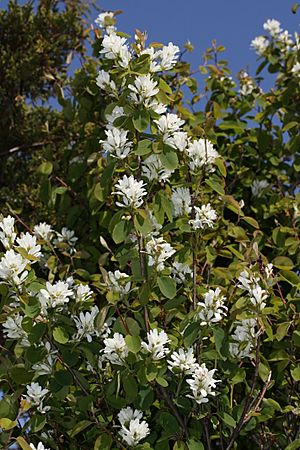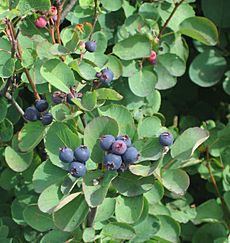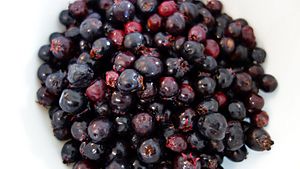Saskatoon berry facts for kids
Quick facts for kids Saskatoon berry |
|
|---|---|
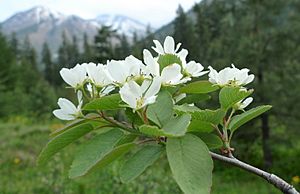 |
|
| A. a. var. semiintegrifolia at Icicle Canyon, Chelan County Washington | |
| Conservation status | |
| Scientific classification | |
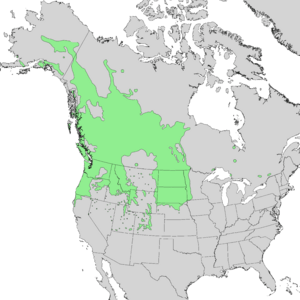 |
|
| Natural range of Amelanchier alnifolia | |
| Synonyms | |
|
Amelanchier alnifolia, the saskatoon, Pacific serviceberry, western serviceberry, alder-leaf shadbush, dwarf shadbush, chuckley pear, or western juneberry, is a shrub with edible berry-like fruit, native to North America from Alaska across most of western Canada and in the western and north-central United States. Historically, it was also called pigeon berry. It grows from sea level in the north of the range, up to 2,600 m (8,530 ft) elevation in California and 3,400 m (11,200 ft) in the Rocky Mountains, and is a common shrub in the forest understory.
Contents
Etymology
The name saskatoon derives from the Cree inanimate noun misâskwatômina (misâskwatômin NI sg, saskatoonberry, misâskwatômina NI pl saskatoonberries). The city of Saskatoon, Saskatchewan, is named after this berry.
The species name alnifolia is a feminine adjective. It is a compound of the Latin word for "alder", alnus, and the word for "leaf", folium.
Description
It is a deciduous shrub or small tree that most often grows to 1–8 m (3–26 ft), rarely to 10 m or 33 ft, in height. Its growth form spans from suckering and forming colonies to clumped.
The leaves are oval to nearly circular, 2–5 cm (3⁄4–2 in) long and 1–4.5 cm (1⁄2–1+3⁄4 in) broad, on a 0.5–2 cm (1⁄4–3⁄4 in) leaf stem, margins toothed mostly above the middle. The foliage is browsed by deer, elk, rabbits, and livestock.
As with all species in the genus Amelanchier, the flowers are white, with five quite separate petals. In A. alnifolia, they are about 2–3 cm (3⁄4–1+1⁄4 in) across, and appear on short racemes of three to 20 somewhat crowded together, in spring while the new leaves are still expanding.
The fruit is a small purple pome 5–15 mm (3⁄16–19⁄32 in) in diameter, ripening in early summer in the coastal areas and late summer further inland. They are eaten by wildlife including birds, squirrels and bears. It is also a larval host to the pale tiger swallowtail, two-tailed swallowtail, and the western tiger swallowtail.
Varieties
The three varieties are:
- A. a. var. alnifolia. Northeastern part of the species' range.
- A. a. var. pumila (Nutt.) A.Nelson. Rocky Mountains, Sierra Nevada.
- A. a. var. semiintegrifolia (Hook.) C.L.Hitchc. Pacific coastal regions, Alaska to northwestern California.
Cultivation and uses
Seedlings are planted with 13–20 feet (4.0–6.1 m) between rows and 1.5–3 feet (0.46–0.91 m) between plants. An individual bush may bear fruit 30 or more years.
Saskatoons are adaptable to most soil types with exception of poorly drained or heavy clay soils lacking organic matter. Shallow soils should be avoided, especially if the water table is high or erratic. Winter hardiness is exceptional, but frost can damage blooms as late as May. Large amounts of sunshine are needed for fruit ripening.
With a sweet, nutty taste, the fruits have long been eaten by Indigenous peoples in Canada, fresh or dried. They are well known as an ingredient in pemmican, a preparation of dried meat to which saskatoon berries are added as flavour and preservative. They are used in saskatoon berry pie, jam, wines, cider, beers, and sugar-infused berries similar to dried cranberries used for cereals, trail mix, and snack foods.
In 2004, the British Food Standards Agency suspended saskatoon berries from retail sales pending safety testing; the ban eventually was lifted after pressure from the European Union.
Diseases and pests
A. alnifolia is susceptible to cedar-apple rust, entomosporium leaf spot, fireblight, brown rot, cytospora canker, powdery mildew, and blackleaf. Problem insects include aphids, thrips, mites, bud moths, Saskatoon sawflies, and pear slug sawflies.
Nutrients
| Nutrients in raw saskatoon berries | ||
| Nutrient | Value per 100 g | % Daily Value |
|---|---|---|
| Energy | 85 kcal | |
| Total dietary fiber | 5.9 g | 20% |
| Sugars, total | 11.4 g | 8% |
| Calcium | 42 mg | 4% |
| Magnesium | 24 mg | 6% |
| Iron | 1 mg | 12% |
| Manganese | 1.4 mg | 70% |
| Potassium | 162 mg | 3% |
| Sodium | 0.5 mg | 0% |
| Vitamin C | 3.6 mg | 4% |
| Vitamin A | 11 IU | 1% |
| Vitamin E | 1.1 mg | 7% |
| Folate | 4.6 µg | 1% |
| Riboflavin | 3.5 mg | > 100% |
| Panthothenic acid | 0.3 mg | 6% |
| Pyridoxine | 0.03 mg | 2% |
| Biotin | 20 µg | 67% |
Saskatoon berries contain significant amounts of total dietary fiber, riboflavin and biotin, and the dietary minerals, iron and manganese, a nutrient profile similar to the content of blueberries.
Polyphenols
Also similar in composition to blueberries, saskatoons have total polyphenol content of 452 mg per 100 g (average of 'Smoky' and 'Northline' cultivars), flavonols (61 mg) and anthocyanins (178 mg), although others have found the phenolic values to be either lower in the 'Smoky' cultivar or higher. Quercetin, cyanidin, delphinidin, pelargonidin, petunidin, peonidin, and malvidin were present in saskatoon berries.
See also
 In Spanish: Guillomo de Saskatchewan para niños
In Spanish: Guillomo de Saskatchewan para niños



